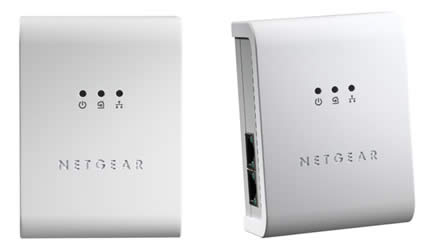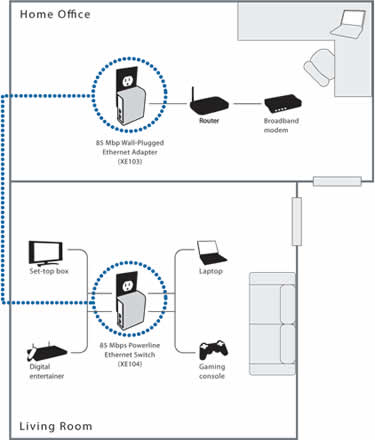 Chris Geiser, Product Line Manager, In-Home Distribution NETGEAR, is an experienced marketer who’s 15-year career has included roles in product management, product marketing, consulting and market research. He has worked for leading technology companies, including Metatec (now Zomax), Intel, Honeywell and NETGEAR, where he has been the product line manager for in-home distribution products since the summer of 2008. Chris holds an MBA from Cornell’s Johnson Graduate School of Management and an undergraduate degree in telecommunications from Ohio University’s Honors Tutorial College.
Chris Geiser, Product Line Manager, In-Home Distribution NETGEAR, is an experienced marketer who’s 15-year career has included roles in product management, product marketing, consulting and market research. He has worked for leading technology companies, including Metatec (now Zomax), Intel, Honeywell and NETGEAR, where he has been the product line manager for in-home distribution products since the summer of 2008. Chris holds an MBA from Cornell’s Johnson Graduate School of Management and an undergraduate degree in telecommunications from Ohio University’s Honors Tutorial College.
Bijan Tehrani: What is the benefit of the Powerline networking compared to wireless networking?
Chris Geiser: Typically, what we are talking about is a whole category of products called Powerline. It is based on a technology that enables you to encode data in an unused portion of your electrical wiring; it uses this unused frequency to transmit and encode data and decode it on the other side. The thing that this technology does that is a little different and better than wireless is that it is a lot less finicky than wireless. It is easier to setup, there is typically no configuration required, and no security issues. If you are trying to set up a connection in your home and you don’t really want to drill holes in your walls, it really gives basic cabling and Internet access, and can provide some wireless extension; you can actually get Internet access in some places that your wireless connection can’t cover. We find a few common objections to wireless: wireless is too complicated, it is difficult, and doesn’t have the same performance particularly over distance, and there are concerns about wireless security, and finally some people are concerned about the environmental issue; the concept of having high powered RF in your home. So Powerline really offers an alternative, and provides the reliability and stability of a wired connection, and in a lot of cases works where wireless doesn’t. If you are in a metal building for example, you will have electrical outlets every six feet, but may not be able to get a strong wireless signal. When you take into account the expense for rewiring your home or small business, Powerline technology uniquely supplements what people can do with wireless. We think of these technologies of  coexisting; they work in the same environment and don’t compete with each other, but Powerline really does offer some additional benefits. You will still need wireless for mobility and flexibility, but if you just need a connection where you don’t have wireless, Powerline is the easiest, most cost effective way to get a high speed Internet connection.
coexisting; they work in the same environment and don’t compete with each other, but Powerline really does offer some additional benefits. You will still need wireless for mobility and flexibility, but if you just need a connection where you don’t have wireless, Powerline is the easiest, most cost effective way to get a high speed Internet connection.
BT: What is the latest that NETGEAR is offering for people who are dealing with video transfers?
CG: We have a product that is called the Powerline AV Ethernet Adapter Kit (XAVB101). It is sold with a kit, and it is basically a cable replacement; instead of having to run a 100 foot cat5 cable, you can plug these devices anywhere in your home or office and be able to get that high speed Internet connection. The technology is based on something called Home Plug AV, which is a tried and true method of securely transferring this Powerline data. It is increasingly driving this in home distribution type of application. The product is rated at 200 megabits per second, but typically the real world performance will be less than half of that. You might see maybe 90 to 100 megabits per second, and perhaps lower. But it really is an easy way to get a reliable network connection anywhere, and the ability to be able to unplug it and reconnect it anywhere without having to change cabling is a really great benefit.
BT: If you have more than one connection, and if they are in different locations, is there any configuration that is needed to take place?
CG: Today, you would basically have to purchase a small four of five port switch, which are relatively cheap, around $20. We are also releasing a product later this year in June/July which is called the XAVB1004, and that is a four port kit, and it is a product that is just like the XAVB101, but it is providing more of a home theater design, and giving your four ports on the device. The application that we have really targeted that for is the home theater space; if you have in your home a BlueRay DVD player which needs to get out into the Internet that needs to get premium connect, along with a DVD and an Xbox or Playstation 3, and all of those devices need an Ethernet connection in order to function properly. So the XAVB1004 will really  address this, and we are doing some interesting things on that product; we are doing a pretty innovative port-based QOS technology design which basically allows you to decide what devices connected to that four port switch receive priority. And there is really no configuration required; for these products we try to give them plug in play capabilities. There is color coding on the product which shows you which ports to attach to and what ports are given priority. That product will be slightly more expensive than the current product, and available pretty much everywhere in the June/July timeframe.
address this, and we are doing some interesting things on that product; we are doing a pretty innovative port-based QOS technology design which basically allows you to decide what devices connected to that four port switch receive priority. And there is really no configuration required; for these products we try to give them plug in play capabilities. There is color coding on the product which shows you which ports to attach to and what ports are given priority. That product will be slightly more expensive than the current product, and available pretty much everywhere in the June/July timeframe.
BT: Is it possible to mix the devices from various manufactures of Powerline based products?
CG: Sure. It requires some additional setup, because there is an encryption key that is shipped with each of the manufacturers’ products, but if you wanted to add a Linksys or Belkin device to an existing Home Plug AV Network you shouldn’t have any problem doing it. It does require you to go into the PC utility and configure the devices. But the great thing about that is that if you are using the NETGEAR utility you can see the other devices from manufacturers and configure them. It is a good feature, and I think as an industry we have done a pretty good job of certifying that these products work together in a seamless fashion. NETGEAR has really been a leader in this space, and has really adopted these new technologies and is bringing out new and innovative products all the time. As the product category grows with more manufacturers building Powerline products, it means that the technology is likely to gain more and more acceptance among consumers.
BT: Where do you expect this technology to go in the next two years?
CG: One of the interesting things about this technology is that it is really in the early stages of its development. We are just starting to see these technologies be adopted by consumer electronics manufacturers and device manufacturers. What we are really looking at is that as these technologies and standards improve, there are going to be all kinds of new applications that are going to drive greater simplification and higher performance, and will be sold as solutions rather than stand alone devices. You will see that in the same way that the establishment of 802.11 really made the wireless technology take off. There are these new standards bodies that are established by the IEEE and ITU (including G.hn and P1901), that are making sure that all of these products are working and are compatible world wide, and that anybody can develop products using these technologies. The great thing that happens when you get multiple manufacturers developing on these same standards is that it drives the cost down (so that it’s comparable to wireless), increasing the number of applications in which you see these things. That means that it is going to be a technology that could potentially be out there in everything that you use. That means that things are going to get simpler and simpler to integrate in a home environment.

